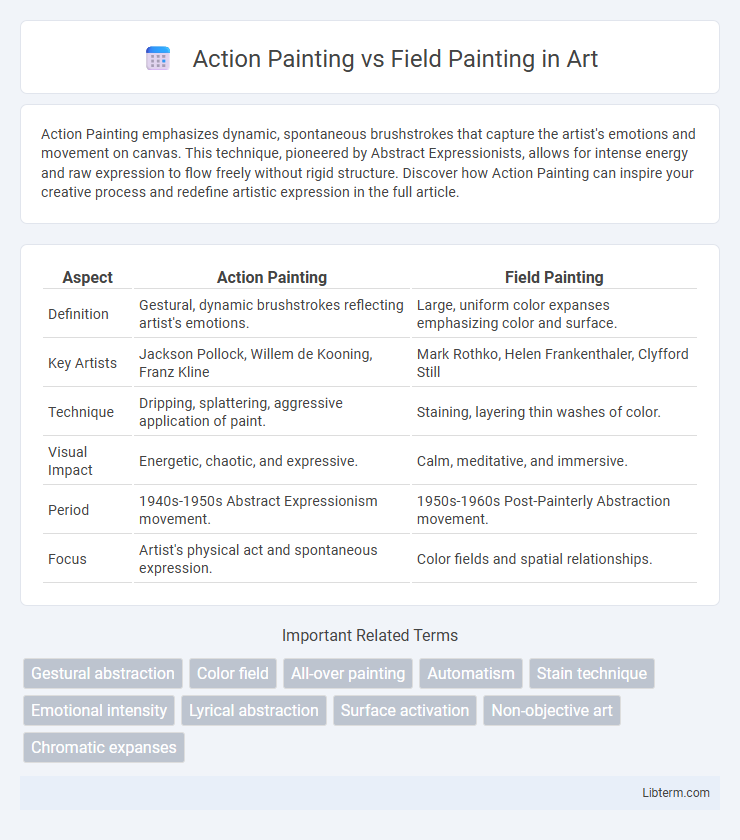Action Painting emphasizes dynamic, spontaneous brushstrokes that capture the artist's emotions and movement on canvas. This technique, pioneered by Abstract Expressionists, allows for intense energy and raw expression to flow freely without rigid structure. Discover how Action Painting can inspire your creative process and redefine artistic expression in the full article.
Table of Comparison
| Aspect | Action Painting | Field Painting |
|---|---|---|
| Definition | Gestural, dynamic brushstrokes reflecting artist's emotions. | Large, uniform color expanses emphasizing color and surface. |
| Key Artists | Jackson Pollock, Willem de Kooning, Franz Kline | Mark Rothko, Helen Frankenthaler, Clyfford Still |
| Technique | Dripping, splattering, aggressive application of paint. | Staining, layering thin washes of color. |
| Visual Impact | Energetic, chaotic, and expressive. | Calm, meditative, and immersive. |
| Period | 1940s-1950s Abstract Expressionism movement. | 1950s-1960s Post-Painterly Abstraction movement. |
| Focus | Artist's physical act and spontaneous expression. | Color fields and spatial relationships. |
Introduction to Action Painting and Field Painting
Action Painting emphasizes dynamic, expressive brushstrokes and spontaneous gestures that capture the artist's physical interaction with the canvas, originating in the 1940s American Abstract Expressionism movement. Field Painting, often associated with Color Field Painting, focuses on large expanses of solid color and subtle tonal variations, aiming to evoke emotional responses through simplicity and color saturation. Both styles revolutionized modern art by prioritizing different aspects of the visual experience--gesture and movement versus color and form.
Historical Origins of Action Painting
Action Painting emerged in the late 1940s and early 1950s as a dynamic development within Abstract Expressionism, pioneered by artists like Jackson Pollock and Willem de Kooning who emphasized spontaneous, vigorous brushstrokes and the physical act of painting. Rooted in the post-World War II cultural shift towards individual expression and existentialism, this style contrasted with the more structured and color-focused Field Painting of artists such as Mark Rothko and Barnett Newman. Action Painting's historical origins reflect a rebellion against traditional artistic conventions, capturing the energy and psychological intensity of its era through gesture and movement on canvas.
Evolution and Key Figures in Field Painting
Field Painting evolved primarily during the mid-20th century as a sub-genre of abstract expressionism defined by expansive color fields and subtle tonal variations, rejecting the gestural intensity of Action Painting. Key figures such as Mark Rothko, Barnett Newman, and Clyfford Still emphasized emotional resonance through vast, flat expanses of color that engage viewers in contemplative experiences. Their work marked a significant shift toward color theory and spatial depth, influencing contemporary art's trajectory toward minimalism and color field art.
Defining Characteristics: Action vs Field Techniques
Action Painting emphasizes spontaneous, dynamic brushstrokes and energetic gestures, capturing the artist's physical engagement with the canvas. Field Painting features large, flat expanses of color applied with minimal visible brushwork, creating an immersive, meditative visual experience. These contrasting techniques highlight the physicality and immediacy of Action Painting versus the calm, uniform presence of Field Painting.
Influential Artists: Pollock, Rothko, and Others
Action Painting, characterized by energetic brushstrokes and spontaneous techniques, was pioneered by Jackson Pollock, whose drip painting style revolutionized Abstract Expressionism. Field Painting, exemplified by Mark Rothko, emphasizes expansive color fields and contemplative composition, creating immersive emotional experiences through large-scale canvases. Other influential artists include Willem de Kooning, merging gestural abstraction with figurative elements, and Barnett Newman, who explored color and form to evoke profound spiritual resonance.
The Role of Gesture and Movement in Action Painting
Gesture and movement are central to Action Painting, where dynamic, spontaneous brushstrokes capture the artist's physical engagement with the canvas, emphasizing emotional intensity and energy. In contrast, Field Painting prioritizes large, flat areas of color with minimal visible brushwork, focusing on color interaction and spatial experience rather than kinetic expression. The physical act and bodily motion in Action Painting serve as a direct extension of the painter's psychological state, making the artwork a record of performance and temporal activity.
The Power of Color and Space in Field Painting
Field Painting explores the dynamic relationship between expansive color areas and spatial depth, emphasizing color's immersive power to evoke emotion and atmosphere. Large, flat planes of vibrant hues create a sense of endless space, inviting viewers into an enveloping visual experience. This contrasts with Action Painting's energetic brushwork, as Field Painting prioritizes the subtleties of color interaction and spatial harmony to define its expressive impact.
Artistic Philosophies and Intentions Compared
Action Painting emphasizes spontaneity, gestural brushstrokes, and the artist's physical engagement with the canvas to capture emotion and movement. Field Painting, associated with Color Field painting, prioritizes large areas of color and flat planes to evoke contemplation and emotional resonance through visual simplicity. Both movements reflect distinct artistic philosophies: Action Painting centers on dynamic expression, while Field Painting aims for meditative space and color harmony.
Impact on the Abstract Expressionism Movement
Action Painting, characterized by vigorous brushstrokes and emphasis on the artist's physical engagement, revolutionized Abstract Expressionism by prioritizing spontaneity and emotional intensity, with Jackson Pollock as a key figure. Field Painting, typified by large, flat areas of color and a more contemplative approach, influenced the movement by introducing a sense of calm and spatial purity, exemplified by Mark Rothko's works. These contrasting techniques collectively expanded the expressive possibilities of Abstract Expressionism, shaping its diverse aesthetic and philosophical dimensions.
Legacy and Contemporary Influence
Action Painting, originating in the 1940s and popularized by artists like Jackson Pollock, revolutionized abstract expressionism through dynamic, gestural brushstrokes that emphasized physical movement and emotional intensity. Field Painting, associated with artists such as Mark Rothko and Barnett Newman, focused on large color fields and minimalistic compositions to evoke contemplative emotional responses. Both styles profoundly influenced contemporary art by inspiring diverse practices in abstract expressionism, minimalism, and performance art, shaping modern approaches to color, scale, and artistic process.
Action Painting Infographic

 libterm.com
libterm.com